
Lyme Regis is a town in west Dorset, England, 25 miles (40 km) west of Dorchester and east of Exeter. Sometimes dubbed the "Pearl of Dorset", it lies by the English Channel at the Dorset–Devon border. It has noted fossils in cliffs and beaches on the Jurassic Coast, a World Heritage Site and heritage coast. The harbour wall, known as The Cobb, appears in Jane Austen's novel Persuasion, the John Fowles novel The French Lieutenant's Woman and the 1981 film of that name, partly shot in the town. A former mayor and MP was Admiral Sir George Somers, who founded the English colonial settlement of Somers Isles, now Bermuda, where Lyme Regis is twinned with St George's. In July 2015, Lyme Regis joined Jamestown, Virginia in a Historic Atlantic Triangle with St George's. The 2011 Census gave the urban area a population of 4,712, estimated at 4,805 in 2019.
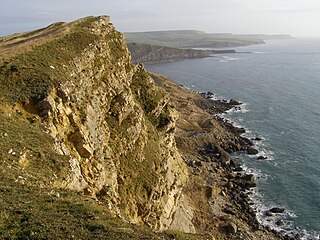
The Jurassic Coast is a World Heritage Site on the English Channel coast of southern England. It stretches from Exmouth in East Devon to Studland Bay in Dorset, a distance of about 96 miles (154 km), and was inscribed on the World Heritage List in mid-December 2001.

The South West Coast Path is England's longest waymarked long-distance footpath and a National Trail. It stretches for 630 miles (1,014 km), running from Minehead in Somerset, along the coasts of Devon and Cornwall, to Poole Harbour in Dorset. Because it rises and falls with every river mouth, it is also one of the more challenging trails. The total height climbed has been calculated to be 114,931 ft (35,031 m), almost four times the height of Mount Everest. It has been voted 'Britain's Best Walking route' twice in a row by readers of The Ramblers' Walk magazine, and regularly features in lists of the world's best walks.

Lulworth Cove is a cove near the village of West Lulworth, on the Jurassic Coast in Dorset, southern England. The cove is one of the world's finest examples of such a landform, and is a World Heritage Site and tourist location with approximately 500,000 visitors every year, of whom about 30 per cent visit in July and August. It is close to the rock arch of Durdle Door and other Jurassic Coast sites.
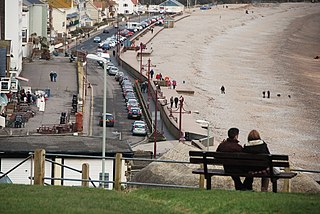
Seaton is a seaside town, fishing harbour and civil parish in East Devon on the south coast of England, between Axmouth and Beer. It faces onto Lyme Bay and is on the Dorset and East Devon Coast Jurassic Coast World Heritage Site. A sea wall provides access to the mostly shingle beach stretching for about a mile, and a small harbour, located mainly in the Axmouth area.

Charmouth is a village and civil parish in west Dorset, England. The village is situated on the mouth of the River Char, around 1+1⁄2 miles (2 km) north-east of Lyme Regis. Dorset County Council estimated that in 2013 the population of the civil parish was 1,310. In the 2011 Census the population of the parish, combined with the small parish of Catherston Leweston to the north, was 1,352.

Chideock is a village and civil parish in south west Dorset, England, situated close to the English Channel between Bridport and Lyme Regis. Dorset County Council's 2013 estimate of the parish population is 550.

Golden Cap is a hill and cliff situated on the English Channel coast between Bridport and Charmouth in Dorset, England. At 191 metres (627 ft), it is arguably the highest point on the south coast of Great Britain and is visible for tens of miles along the coastline. It is accessible via a coastal footpath from Seatown, and takes around 40 minutes to reach the summit.

Lyme Bay is an area of the English Channel off the south coast of England. The south western counties of Devon and Dorset front onto the bay.
The Undercliff is the name of several areas of landslip on the south coast of England. They include ones on the Isle of Wight; on the Dorset-Devon border near Lyme Regis; on cliffs near Branscombe in East Devon; and at White Nothe, Dorset. All arose from slump of harder strata over softer clay, giving rise to irregular landscapes of peaks, gullies and slipped blocks, that have become densely vegetated due to their isolation and change of land use. The Kent coast at Folkestone and Sandgate also has similar undercliff areas.
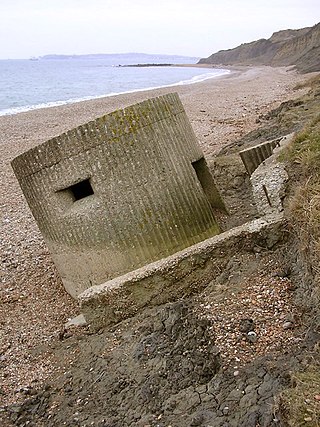
Redcliff Point is on the south coast of England, to the east of Weymouth in Dorset. It lies just past the eastern end of the sweeping Weymouth Bay on the Jurassic Coast, a UNESCO World Heritage landscape known for its geology. Fossils can be found in the Upper Oxford Clay in this area.
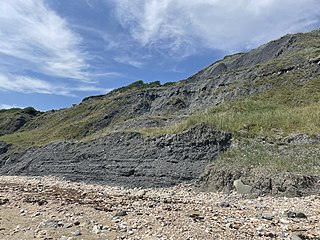
Black Ven is a cliff in Dorset, England between the towns of Charmouth and Lyme Regis. The cliffs reach a height of 130 metres (430 ft). It is part of the Jurassic Coast World Heritage Site. Nearby is an undercliff with an ammonite pavement. The area is popular with tourists due to a number of fossils being found in the area.

The Spittles is an area of coastal cliff in the county of Dorset on the south coast of England. It is situated between the settlements of Lyme Regis to the west and Charmouth to the east. It forms part of the Jurassic Coast, a World Heritage Site designated in 2001. The cliff contains layers of Blue Lias and clay; in wet seasons the clay causes the layers above to become saturated and hence landslips occur, exposing many fossils. Mary Anning famously found an Ichthyosaurus in the Spittles.
Stonebarrow is a coastal hill and sea cliff in the county of Dorset on the south coast of England. It is a well known fossil hunting location, close to the coastal village of Charmouth.

Dinosaurland Fossil Museum is a privately owned fossil museum in Lyme Regis, on the Jurassic Coast in Dorset, England. The museum is located in a historic Grade I listed former congregational church building.

The Lulworth Ranges are military firing ranges located between Wareham and Lulworth in Dorset, England. They cover an area of more than 2,830 hectares, are leased in a rolling contract from the Weld Estate by the Ministry of Defence and are part of the Armoured Fighting Vehicles Gunnery School based at Lulworth Camp. The ranges were established in 1917.

The Dinosaur Museum is a museum presenting dinosaurs in Dorchester, the county town of Dorset, in southern England.
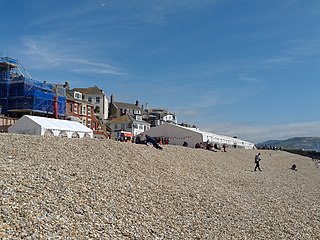
The Lyme Regis Fossil Festival is an annual festival held at Lyme Regis on the Jurassic Coast of East Devon and Dorset. It exists to celebrate the unique geological heritage of Lyme Regis and the Jurassic Coast and to educate the public on advances in natural environment research, and especially palaeontology. It is organised by the Lyme Regis Development Trust with major support from the Natural History Museum in London and the Jurassic Coast team.
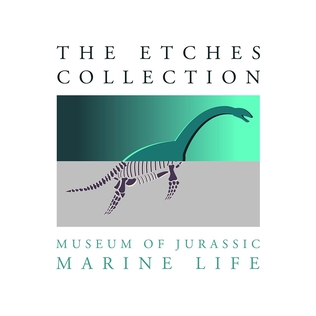
The Etches Collection is an independent fossil museum located in the village of Kimmeridge, Purbeck, Dorset, England. It is based on the lifetime collection of Steve Etches, a fossil hunter for whom some of his finds have been named, from the local area on the Jurassic Coast, an SSI and World Heritage Site, especially around Kimmeridge Bay and the Kimmeridge Ledges.


















